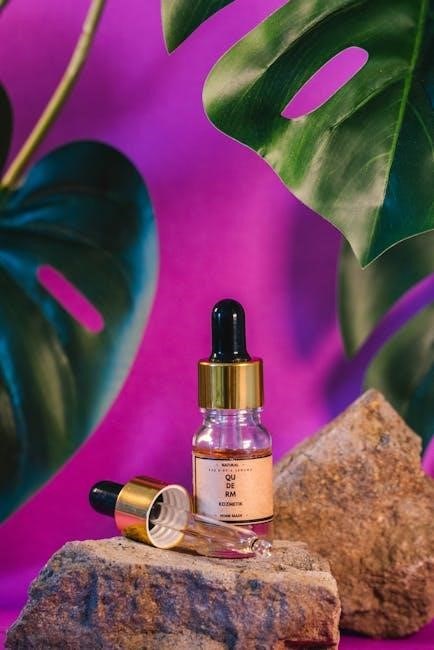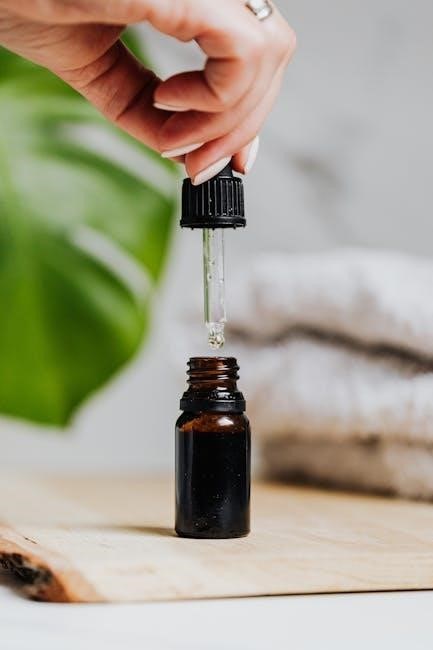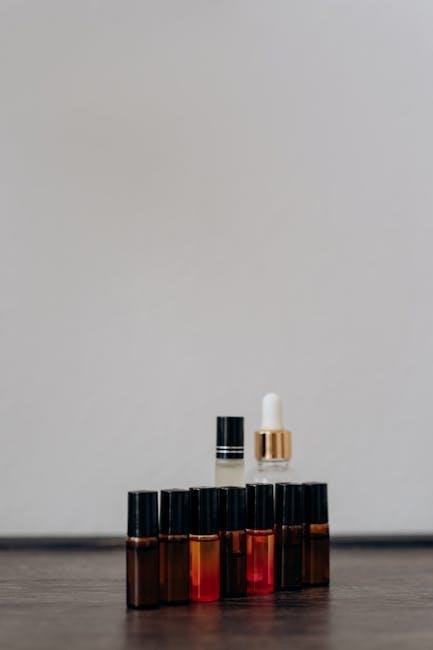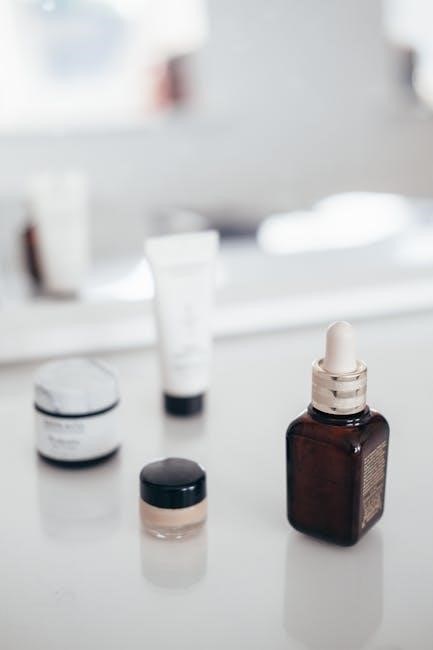Essential oils are natural‚ aromatic liquids extracted from plants‚ offering diverse therapeutic benefits. Their uses range from aromatherapy to medicinal applications‚ with comprehensive guides like the essential oil list and their uses PDF providing detailed insights into their versatile applications and benefits.
1.1. Definition and Origin
Essential oils are highly concentrated‚ aromatic liquids extracted from plants‚ flowers‚ roots‚ and other organic materials. They are obtained through methods like distillation‚ cold pressing‚ or solvent extraction. These oils capture the plant’s essence and fragrance‚ making them valuable for therapeutic‚ medicinal‚ and cosmetic uses. Originating from ancient civilizations in Egypt‚ China‚ and Greece‚ essential oils have been used for centuries in perfumes‚ rituals‚ and traditional medicine‚ with their popularity enduring through modern times.

1.2. Historical Use of Essential Oils
Essential oils have been used for thousands of years in ancient cultures for medicinal‚ spiritual‚ and cosmetic purposes. Egyptians employed them in mummification and perfumes‚ while Chinese and Greek civilizations utilized them for health and rituals. The foundation of modern aromatherapy was laid by French chemist René-Maurice Gattefossé in the early 20th century. These natural extracts have since evolved into a global phenomenon‚ cherished for their versatility and therapeutic properties.
1.3. Modern Applications of Essential Oils
Today‚ essential oils are widely used in aromatherapy‚ healthcare‚ and wellness practices. They are valued for their therapeutic properties‚ aiding in pain relief‚ stress reduction‚ and skin health. Modern applications include natural cleaning products‚ skincare routines‚ and mental health support. Oils like frankincense and peppermint are popular for their anti-inflammatory and digestive benefits. The rise of DIY recipes and printable guides‚ such as the essential oil list and their uses PDF‚ has made these natural remedies accessible for home use‚ promoting holistic living and sustainability.

Chemical Composition of Essential Oils
Essential oils are composed of bioactive compounds like terpenes‚ phenols‚ and esters‚ each offering unique therapeutic benefits such as anti-inflammatory and antimicrobial properties.
2.1. Key Components (Terpenes‚ Phenols‚ Esters)
Essential oils contain terpenes‚ which are known for their anti-inflammatory properties‚ phenols‚ recognized for their antimicrobial effects‚ and esters‚ which are often calming and soothing. These components are responsible for the diverse therapeutic benefits of essential oils‚ making them valuable in aromatherapy and natural remedies. Understanding these key components is crucial for utilizing essential oils effectively and safely‚ as outlined in resources like the essential oil list and their uses PDF.
2.2. Bioactive Compounds and Their Properties
Essential oils are rich in bioactive compounds like terpenes‚ phenols‚ and esters‚ each offering unique properties. These compounds contribute to the oils’ therapeutic effects‚ such as anti-inflammatory‚ antimicrobial‚ and antioxidant activities; For instance‚ terpenes can enhance mental clarity‚ while phenols are known for their cleansing properties. These properties are well-documented in guides like the essential oil list and their uses PDF‚ providing a comprehensive understanding of their applications and benefits in natural health and wellness practices.
Benefits of Essential Oils
Essential oils offer numerous therapeutic and emotional benefits‚ from relieving stress to boosting immunity. Their natural properties make them versatile for health and wellness‚ as detailed in the essential oil list and their uses PDF.
3.1. Therapeutic and Medicinal Benefits
Essential oils are renowned for their therapeutic and medicinal properties‚ offering natural solutions for various health conditions. They are used to alleviate pain‚ reduce inflammation‚ and combat infections. Oils like frankincense and eucalyptus are known for their anti-inflammatory and decongestant effects‚ while peppermint and ginger oils aid in digestive relief. These oils can also support mental health by reducing stress and anxiety. The essential oil list and their uses PDF highlights their diverse applications‚ providing evidence-based benefits for holistic well-being and disease prevention. Proper usage ensures safety and effectiveness.
3.2. Emotional and Psychological Benefits
Essential oils have profound emotional and psychological benefits‚ offering natural solutions for stress‚ anxiety‚ and mood enhancement. Oils like lavender and bergamot are known for their calming effects‚ promoting relaxation and reducing anxiety. Others‚ such as frankincense and ylang-ylang‚ help alleviate emotional distress and improve mental clarity. The essential oil list and their uses PDF provides insights into how these oils can be used in aromatherapy to uplift mood‚ enhance emotional well-being‚ and create a sense of balance. Their aromatic properties make them ideal for holistic emotional care.
Popular Essential Oils and Their Uses
Essential oils like lavender‚ tea tree‚ and frankincense are widely used for their therapeutic properties. The essential oil list and their uses PDF highlights their benefits‚ from calming to anti-inflammatory effects.
4.1. Lavender Oil: Calming and Skin Benefits
Lavender oil‚ known for its calming properties‚ is widely used to promote relaxation and improve sleep quality. It has a soothing effect on the skin‚ making it ideal for treating acne‚ eczema‚ and sunburns. The oil’s antiseptic and anti-inflammatory properties help in healing wounds and reducing redness. Lavender oil is also beneficial for stress relief and anxiety‚ creating a sense of peace. Its mild scent and versatility make it a popular choice for aromatherapy and skincare products‚ as highlighted in the essential oil list and their uses PDF.
4.2. Tea Tree Oil: Antimicrobial Properties
Tea tree oil‚ derived from Melaleuca alternifolia‚ is renowned for its potent antimicrobial properties‚ making it effective against bacteria‚ viruses‚ and fungi. It is commonly used to treat acne‚ reduce inflammation‚ and combat fungal infections like athlete’s foot. The oil’s antiseptic properties also make it ideal for soothing minor wounds and cuts. Additionally‚ tea tree oil is valued for its fresh‚ cleansing scent and is often incorporated into natural cleaning products. Its versatility and health benefits are well-documented in the essential oil list and their uses PDF.
4.3. Peppermint Oil: Digestive and Cooling Effects
Peppermint oil‚ extracted from Mentha piperita‚ is celebrated for its invigorating aroma and dual benefits. It aids digestion by easing nausea and bloating‚ while its cooling properties provide relief from muscle tension and headaches. The oil’s menthol content creates a refreshing sensation‚ making it popular in topical applications and aromatherapy. Its versatility extends to skincare and respiratory support‚ as highlighted in the essential oil list and their uses PDF‚ showcasing its wide range of natural health applications.
4.4. Frankincense Oil: Anti-Inflammatory Properties
Frankincense oil‚ derived from the resin of Boswellia serrata‚ is renowned for its potent anti-inflammatory and healing properties. It has been used historically to reduce pain‚ swelling‚ and arthritis symptoms. The oil’s ability to modulate inflammation makes it beneficial for skin conditions like acne and wounds. Its calming effects also support emotional well-being. As detailed in the essential oil list and their uses PDF‚ frankincense is a versatile natural remedy for both physical and mental health‚ promoting overall wellness and relaxation.
4.5. Eucalyptus Oil: Respiratory Benefits
Eucalyptus oil‚ extracted from the leaves of Eucalyptus globulus‚ is highly valued for its strong decongestant and expectorant properties‚ making it a natural remedy for respiratory issues. It alleviates symptoms of coughs‚ colds‚ and sinusitis by opening airways and reducing inflammation. Its fresh‚ minty aroma is invigorating and often used in aromatherapy to enhance mental clarity and reduce stress. As noted in the essential oil list and their uses PDF‚ eucalyptus oil is also effective against mental fatigue and can be blended with other oils for enhanced benefits.
4.6. Rosemary Oil: Cognitive and Pain Relief
Rosemary oil‚ derived from Rosmarinus officinalis‚ is renowned for its cognitive-enhancing properties‚ improving memory and mental clarity. It also offers natural pain relief by reducing inflammation and alleviating muscle tension. As highlighted in the essential oil list and their uses PDF‚ rosemary oil is often used in aromatherapy to boost focus and reduce fatigue. Topically applied with a carrier oil or inhaled‚ it provides holistic benefits for both mind and body‚ making it a versatile addition to natural wellness routines.
4.7. Geranium Oil: Hormonal Balance and Skin Health
Geranium oil‚ extracted from Pelargonium graveolens‚ is valued for its ability to balance hormones and promote emotional well-being. It is particularly beneficial for women‚ easing menstrual discomfort and menopausal symptoms. As noted in the essential oil list and their uses PDF‚ geranium oil also supports skin health by reducing inflammation and combating acne. Its antimicrobial properties make it ideal for natural skincare routines‚ while its floral scent provides a calming effect‚ enhancing both physical and emotional health through aromatherapy and topical application.
4.8. Bergamot Oil: Mood Enhancement and Antiseptic Properties
Bergamot oil‚ derived from the rind of Citrus aurantium bergamia‚ is renowned for its uplifting and mood-enhancing qualities. As highlighted in the essential oil list and their uses PDF‚ it helps reduce anxiety and stress‚ promoting a sense of calm. Bergamot oil also possesses antiseptic properties‚ making it effective in treating minor wounds and skin irritations. Its citrusy aroma is popular in aromatherapy‚ while its ability to balance emotions and support immune health makes it a versatile addition to natural wellness routines and skincare products.

Carrier Oils: Uses and Importance
Carrier oils like coconut and jojoba are used to dilute essential oils‚ ensuring safe skin application. They enhance absorption and provide moisturizing benefits‚ essential for aromatherapy and skincare routines.
5.1. What Are Carrier Oils?
Carrier oils are non-volatile plant-derived oils used to dilute essential oils‚ enhancing their safe application on skin. They are rich in nutrients and fatty acids‚ providing moisturizing benefits. Common examples include coconut‚ jojoba‚ and sweet almond oils. Unlike essential oils‚ carriers have a mild scent and longer shelf life‚ making them ideal for skincare and aromatherapy. They play a crucial role in blending and diluting essential oils for safe topical use‚ ensuring effective absorption and minimizing risks of irritation.
5.2. Popular Carrier Oils (Coconut‚ Jojoba‚ Sweet Almond)
Coconut oil‚ a popular carrier oil‚ is known for its moisturizing and antimicrobial properties‚ making it ideal for skin care. Jojoba oil closely resembles the skin’s natural sebum‚ offering excellent hydration and balance. Sweet almond oil is rich in vitamins and fatty acids‚ beneficial for soothing and softening skin. These oils are commonly used in aromatherapy and skincare products due to their ability to blend seamlessly with essential oils‚ enhancing their effectiveness and ensuring safe application. Their versatility makes them favorites among natural health enthusiasts.
5.3. Role in Diluting Essential Oils
Carrier oils play a crucial role in diluting essential oils‚ ensuring safe application on the skin. They prevent irritation and enhance absorption‚ making essential oils more effective. Guidelines often recommend dilution ratios‚ such as 1-3% essential oil concentration‚ to avoid adverse reactions. Using carrier oils like coconut‚ jojoba‚ or sweet almond oil helps maintain skin health while maximizing the therapeutic benefits of essential oils. Proper dilution is essential for both topical use and aromatherapy practices‚ promoting overall well-being and safety.

Safety and Precautions
Essential oils require cautious use to avoid skin irritation and allergic reactions. Always dilute with carrier oils‚ perform patch tests‚ and avoid photosensitizing oils. Consult professionals for safe usage.
6.1. Essential Oil Dilution Guidelines
Essential oils are highly concentrated‚ requiring proper dilution for safe use. Typically‚ a 1-3% dilution ratio is recommended‚ using carrier oils like coconut or jojoba. For adults‚ 5-15 drops per teaspoon of carrier oil is standard. For children or sensitive skin‚ start with 0.5-1%. Always perform a patch test before widespread use. Avoid applying undiluted oils directly to the skin‚ especially for children or pregnant individuals. Consult a professional for personalized dilution advice to ensure safety and effectiveness.
6.2; Photosensitizing Essential Oils
Certain essential oils‚ such as bergamot‚ lemon‚ and grapefruit‚ contain compounds that can cause skin sensitivity to sunlight. These photosensitizing oils may lead to sunburn or skin discoloration when exposed to UV light. To avoid adverse effects‚ avoid applying these oils to skin areas exposed to sunlight. Always consult the essential oil list and their uses PDF for specific safety guidelines and precautions to ensure safe usage‚ especially for outdoor activities or sun exposure.
6.3. Allergies and Sensitivities
Essential oils‚ while natural‚ can cause allergic reactions or sensitivities in some individuals. Common allergenic oils include tea tree‚ lavender‚ and eucalyptus. Symptoms may range from mild skin irritation to severe reactions. Always perform a patch test before using a new oil. Diluting essential oils with carrier oils can minimize risks. Consulting the essential oil list and their uses PDF helps identify potential allergens and provides safe usage guidelines to avoid adverse reactions and ensure safe application.

Essential Oil Applications
Essential oils are versatile‚ used in aromatherapy‚ diffusion‚ and topical applications. They enhance well-being‚ clean households‚ and promote relaxation. Guides like the essential oil list and their uses PDF provide practical insights for safe and effective use.
7.1. Aromatherapy and Diffusion
Aromatherapy involves the use of essential oils to promote physical‚ emotional‚ and mental well-being. Diffusion is a popular method‚ releasing oil particles into the air to enhance mood and relaxation. Essential oils like lavender and peppermint are commonly used for their calming and invigorating effects. Guides such as the essential oil list and their uses PDF provide detailed blends and safety tips for effective aromatherapy practices‚ ensuring safe and beneficial experiences for users.
7.2. Topical Use and Skin Care
Essential oils are widely used in skin care for their therapeutic properties. Oils like lavender and tea tree are renowned for their ability to soothe and heal skin conditions‚ while rosemary and frankincense are often used to rejuvenate and protect the skin. When applied topically‚ they can address issues like acne‚ inflammation‚ and aging. Carrier oils‚ such as coconut or jojoba‚ are typically used to dilute essential oils‚ enhancing absorption and safety. Guides like the essential oil list and their uses PDF offer detailed recipes for natural skin care products.
7.3. Household and Cleaning Uses
Essential oils are a natural alternative for household cleaning‚ offering antibacterial and antifungal properties; Oils like lemon‚ tea tree‚ and eucalyptus are commonly used in homemade cleaning solutions‚ such as all-purpose cleaners and disinfectants. They can also freshen the air and eliminate odors. Many essential oils are versatile and can be combined with vinegar or baking soda for effective cleaning. Guides like the essential oil list and their uses PDF provide recipes and tips for using these oils to create safe and eco-friendly cleaning products.

DIY Recipes Using Essential Oils
Essential oils inspire countless DIY creations‚ from skin care to household cleaners‚ as detailed in guides like the essential oil list and their uses PDF‚ enhancing home and well-being naturally.
8.1. Skin Care Products (Creams‚ Lotions)
Essential oils are widely used in DIY skin care products like creams and lotions due to their therapeutic properties. Lavender oil‚ known for its calming effects‚ is ideal for soothing skin irritations‚ while tea tree oil’s antimicrobial properties make it perfect for acne treatments. Rosehip oil‚ rich in vitamins A and C‚ promotes skin regeneration. By combining these oils with carrier oils like coconut or jojoba‚ you can create natural‚ nourishing products tailored to specific skin types. Printable guides‚ such as the essential oil list and their uses PDF‚ offer detailed recipes and safety tips for homemade skin care creations.
8.2. Natural Cleaning Solutions
Essential oils are excellent for creating natural cleaning solutions due to their antiseptic and antiviral properties. Lemon oil‚ with its fresh scent‚ is ideal for disinfecting surfaces‚ while eucalyptus oil’s deodorizing effects make it perfect for refreshing rooms; Tea tree oil‚ known for its antimicrobial benefits‚ is great for cleaning bathrooms and kitchens. By mixing these oils with water or vinegar‚ you can create eco-friendly cleaners. The essential oil list and their uses PDF provides recipes for homemade cleaning products that are both effective and environmentally friendly.
8.3. Aromatherapy Blends for Mood Enhancement
Aromatherapy blends using essential oils can significantly enhance mood and emotional well-being. Lavender oil‚ known for its calming properties‚ can be combined with bergamot oil’s uplifting scent to create a relaxing yet refreshing blend. Frankincense and ylang-ylang oils are also popular for reducing stress and anxiety. The essential oil list and their uses PDF offers various recipes‚ such as mixing peppermint and eucalyptus for mental clarity or rosemary and lemon for energy. These blends can be used in diffusers or diluted with carrier oils for topical use‚ promoting balance and positivity.

Essential Oils for Specific Health Conditions
Essential oils like frankincense‚ eucalyptus‚ and lavender are used to address specific health conditions such as pain relief‚ respiratory issues‚ and mental health support effectively.
9.1. Essential Oils for Pain Relief
Essential oils like frankincense‚ eucalyptus‚ and lavender are renowned for their pain-relieving properties. Frankincense oil reduces inflammation and alleviates arthritis symptoms‚ while eucalyptus oil eases muscle tension and joint pain. Lavender oil is known for its analgesic and anti-inflammatory effects‚ providing relief from chronic pain and improving sleep quality. These oils can be used topically‚ often diluted with carrier oils‚ or inhaled for therapeutic benefits‚ making them natural alternatives for managing various types of pain effectively.
9.2. Essential Oils for Respiratory Issues
Essential oils like eucalyptus‚ peppermint‚ and tea tree are effective for respiratory issues. Eucalyptus oil‚ with its decongestant properties‚ eases bronchitis and sinus congestion. Peppermint oil provides cooling relief for coughs and sinus pressure. Tea tree oil’s antimicrobial properties combat respiratory infections. Rosemary and thyme oils also support lung health‚ reducing inflammation and fighting pathogens. These oils can be diffused‚ inhaled‚ or applied topically with carrier oils‚ offering natural relief for asthma‚ colds‚ and other respiratory ailments.
9.3. Essential Oils for Mental Health
Essential oils like bergamot‚ frankincense‚ and ylang-ylang are renowned for their mental health benefits. Bergamot oil reduces anxiety and stress with its uplifting citrus scent. Frankincense promotes relaxation and emotional balance‚ while ylang-ylang calms the mind and alleviates depression. Sandalwood oil enhances mindfulness and reduces nervous tension. These oils‚ when diffused or applied topically with carrier oils‚ offer natural support for managing anxiety‚ depression‚ and stress‚ promoting mental well-being and emotional stability.
Conservation and Sustainability
Essential oils from endangered plants like rosewood highlight conservation needs. Ethical sourcing ensures sustainability‚ protecting ecosystems and promoting eco-friendly practices in the essential oil industry.
10.1. Endangered Plants and Essential Oils
Certain plants used for essential oils‚ like rosewood‚ are threatened by over-harvesting and deforestation. The essential oil list and their uses PDF highlights endangered species‚ emphasizing the need for sustainable practices. Conservation efforts are vital to protect these plants and their ecosystems‚ ensuring future availability of essential oils. Ethical sourcing and reforestation programs play a crucial role in maintaining biodiversity and preventing extinction of these valuable botanical resources.
10.2. Ethical Sourcing Practices
Ethical sourcing practices in the essential oil industry involve aligning with environmental conservation efforts and fair labor standards. Many companies collaborate with local farmers to promote sustainable harvesting and fair trade. This ensures that essential oils are sourced responsibly‚ protecting both biodiversity and livelihoods. The essential oil list and their uses PDF often highlights such practices‚ emphasizing the importance of eco-friendly methods and ethical considerations in the production process.

Essential Oil Research and Studies
Research on essential oils focuses on their bioactive compounds and therapeutic potential. Studies validate their health benefits‚ with ongoing investigations into oils like frankincense and peppermint for medical applications.
11.1. Scientific Evidence for Health Benefits
Scientific studies have validated the health benefits of essential oils‚ such as their antimicrobial‚ anti-inflammatory‚ and antioxidant properties. For instance‚ tea tree oil’s antimicrobial effects are well-documented‚ while frankincense oil shows promise in reducing inflammation. Peppermint oil’s ability to alleviate digestive issues and relieve pain has also been supported by research. These findings highlight the potential of essential oils as complementary therapies for various health conditions‚ backed by growing evidence from clinical trials and laboratory studies.
11.2. Emerging Trends in Essential Oil Research
Research into essential oils is expanding‚ focusing on their pharmacological potential and sustainable production. Studies explore their efficacy against diseases like cancer and HIV‚ while advancements in extraction methods aim to enhance oil quality. Additionally‚ there is a growing interest in the psychological benefits of essential oils‚ particularly in mental health. These trends highlight the evolving role of essential oils in modern medicine and wellness‚ supported by innovative technologies and interdisciplinary studies.

Resources and References
Access comprehensive guides like the essential oil list and their uses PDF for detailed information. Explore printable charts‚ expert books‚ and online forums for enhanced learning and application.
12.1. Printable Essential Oil Guides
Printable essential oil guides‚ such as the essential oil list and their uses PDF‚ offer a convenient way to explore and organize information. These guides provide detailed profiles of various oils‚ their therapeutic benefits‚ and safe usage tips. Many include dilution charts‚ safety precautions‚ and DIY recipes for skincare‚ cleaning‚ and aromatherapy. They serve as invaluable resources for both beginners and experienced users‚ ensuring safe and effective essential oil practices. Download these guides to enhance your knowledge and application of essential oils.
12.2. Recommended Books and Journals
For in-depth knowledge‚ recommended books like The Complete Book of Essential Oils and Aromatherapy by Valerie Ann Wormwood and Handbook of Essential Oils by K. Hüsnü Can Baser are highly regarded. These resources provide scientific insights‚ historical context‚ and practical applications of essential oils. Journals and publications from experts in aromatherapy and natural medicine further enhance understanding. These materials are invaluable for enthusiasts and researchers seeking comprehensive and evidence-based information on essential oils and their uses.
12;3. Online Communities and Forums
Online communities and forums dedicated to essential oils provide valuable resources‚ discussions‚ and expert advice. Websites like Oshu Oils offer printable guides‚ safety tips‚ and recipes. These platforms foster knowledge sharing among enthusiasts‚ covering topics from safety precautions to DIY recipes. They also highlight emerging trends and research‚ making them indispensable for both beginners and experienced users seeking to maximize the benefits of essential oils in their daily lives.
